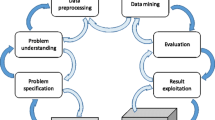Abstract
Semistructured data are specified in lack of any fixed and rigid schema, even though typically some implicit structure appears in the data. The huge amounts of on-line applications make it important and imperative to mine the schema of semistructured data, both for the users (e.g., to gather useful information and facilitate querying) and for the systems (e.g., to optimize access). The critical problem is to discover the hidden structure in the semistructured data. Current methods in extracting Web data structure are either in a general way independent of application background, or bound in some concrete environment such as HTML, XML etc. But both face the burden of expensive cost and difficulty in keeping along with the frequent and complicated variances of Web data. In this paper, the problem of incremental mining of schema for semistructured data after the update of the raw data is discussed. An algorithm for incrementally mining the schema of semistructured data is provided, and some experimental results are, also given, which show that incremental mining for semistructured data is more efficient than non-incremental mining.
Similar content being viewed by others
References
Fayyad U M, Piatetsky-Shapiro G, Smyth P, Uthurusamy R. Advances inKnowledge Discovery and Data Mining. AAAI/MIT Press, 1996.
Chen M S, Han J H, Yu P S. Data mining: An overview from a database perspective.IEEE Trans. KDE, Dec. 1996, 8(6): 866–883.
Agrawal R, Imielinski T, Swami A. Mining association rules between sets of items in large databases. InProc. the ACM SIGMOD Conference on Management of Data. Washington, D. C., May 1993.
Agrawal R, Srikant R. Fast Algorithms for mining association rules. InProc. the 20th Int. Conference on Very Large Databases, Santiago, Chile, Sept. 1994.
Srikant R, Agrawal R. Mining generalized association rules. InProc. the 21st Int. Conference on Very Large Databases, Zurich, Switzerland, Sept. 1995.
Fu Y, Han J. Meta-rule-guided mining of association rules in relational databases. InProc. 1st Int. Workshop on Integration of Knowledge Discovery with Deductive and Object-Oriented Databases (KDOOD’95), Singapore, Dec. 1995, pp.39–46.
Koperski K, Han J. Discovery of spatial association rules in geographic information databases. InAdvances in Spatial Databases, Proceedings of 4th Symposium, SSD’95, (Aug.6–9, Portiand, Maine). Springer-Verlag, Berlin. 1995, pp.47–66.
Nestorov S, Abiteboul S, Motwani R. Inferring structure in semistructured data. (http://www.cs.stanford.edu/~rajeev)
Wang K, Liu H Q. Schema discovery for semistructured data. InProc. KDD’97.
Arocena G O, Mendelzon A O. WebOQL: Restructuring documents, databases and Webs. InProc. ICDE, Orlando, Florida, USA, February 1998.
Lakshmanan L, Sadri F, Subramanian I. A declarative language for querying and restructuring the Web. InProc. 6th Int. Workshop on Research Issues in Data Engineering, New Orleans, 1996.
Mendelzon A O, Mihaila G, Milo T. Querying the World Wide Web. InProc. PDIS’96, Miami, December 1996.
Papakonstantinow Y, Garcia-Marlia H, Widom J. Object exchange, across heterogeneous information sources. InProc. ICDE, Taiwan, march 1995, pp.251–260,
Cheung D W, Han J, Wong C Y. Maintenance of discovered association rules in large databases: An incremental updating technique. InProc. ICDE, New Orleans, LA., Feb. 1996.
Author information
Authors and Affiliations
Corresponding author
Additional information
This work was supported by the National Natural Science Foundation of China, the National 973 Fundamental Research Programme of China and the Doctoral Programme Foundation of Higher-Education.
ZHOU Aoying received his M.S. degree in computer science from Chengdu University of Science and Technology in 1988, and his Ph.D. degree in computer software from Fudan University in 1993. He is currently a Professor in the Department of Computer Science, Fudan University His main research interests include object-oriented data model for multimedia information, CIMS data management, data mining and data warehousing, the novel database technologies and their application in digital library and electronic commerce.
JIN Wen received his M.S. degree in computer science from Southeast University in 1996. He is currently a Ph.D. candidate at the Computer School of Simon Fraser University, Canada. His current research interests include databases, data warehouses and data mining.
ZHOU Shuigeng is currently a Ph.D. candidate at Computer Science Department, Fudan University. He received his B.E. degree and M.E. degree, both in electronic engineering, from Huazhong University of Science and Technology, University of Electronic Science and Technology in 1988 and 1991, respectively. Before he started his Ph.D. program, he was a senior electronic engineer at the General Design Department of Shanghai Space-flight Academy. His current research areas cover databases, data warehousing, data mining and information retrieval.
QIAN Weining is a graduate student at Computer Science Department, Fudan University. His current research interests are databases and data mining
TIAN Zengping received the Ph.D. degree in computer science from Fudan University in 1997. He is currently an associate Professor at the same university. Dr. Tian’s research interests include database, multimedia database, workflow and Web mining.
Rights and permissions
About this article
Cite this article
Zhou, A., Jin, W., Zhou, S. et al. Incremental mining of the schema of semistructured data. J. Comput. Sci. & Technol. 15, 241–248 (2000). https://doi.org/10.1007/BF02948811
Received:
Revised:
Issue Date:
DOI: https://doi.org/10.1007/BF02948811




